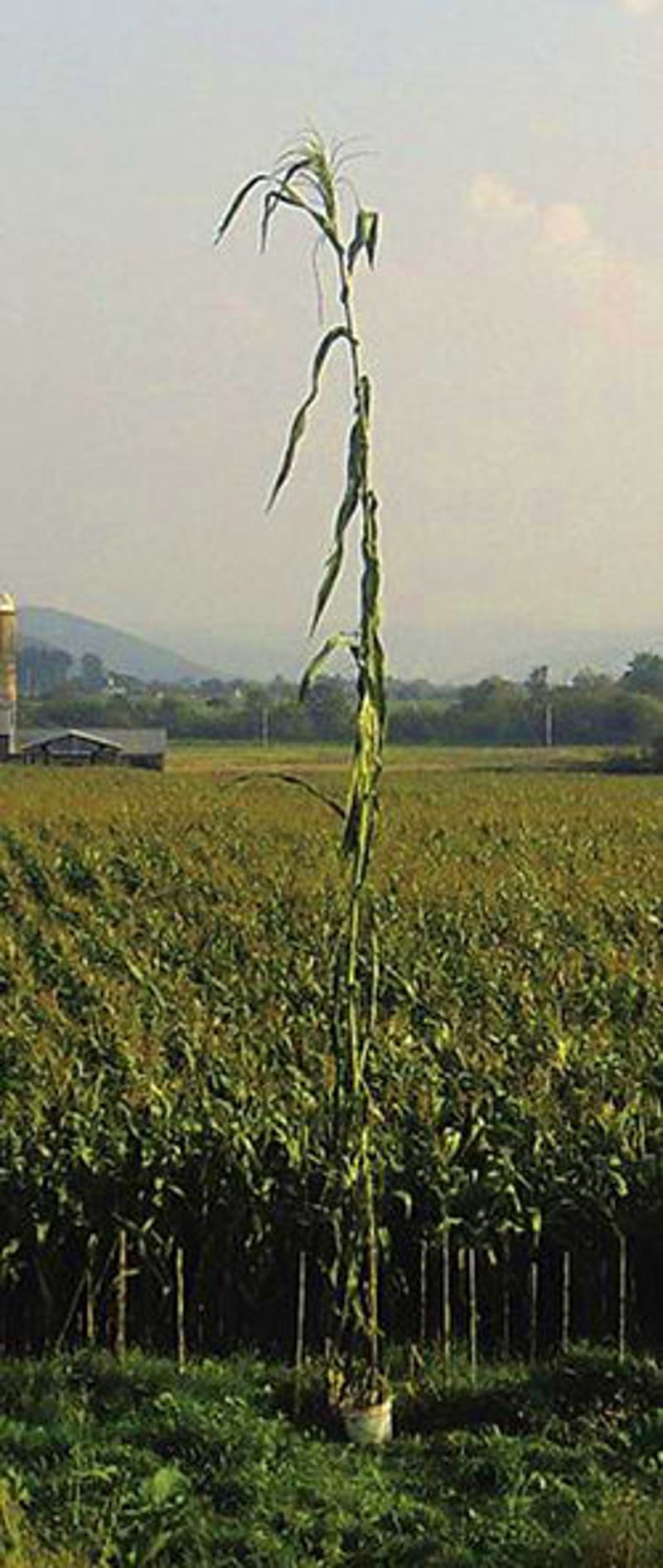Zonnebloemen en Mais
De juiste zaad en bescherming is al wat je nodig hebt voor zonnebloemen en maïs. Dat en veel zon, hoewel sommige kwekers schermen de top van de zonnebloemplant af met een emmer zo dat het meer en meer naar boven groeit richting de zon. Het liefst groeien allebei tegen een warme zuidmuur. Zorg wel voor voldoende voeding (vooral veel stikstof) en voldoende water. Grond in de buurt van muren droogt snel uit. Wind zorgt voor kortere en dikkere planten.
Zonnebloempitten kunnen rond half mei geplant worden. Ter plekke of eerst in potten binnen. Maïs kan absoluut niet tegen kou. Je kunt ze tegelijk met de zonnebloemen buiten planten, of zoals de top kwekers, al in maart, maar dan binnen met verwarming en kunstlicht of een raam. In dit geval moet je eind mei de plant eerst goed afharden voor je het buiten plant.

Growing Tall Corn
First of all, corn is not a vegetable and secondly, corn isn’t really the right name. To start with the latter, corn comes from the German word Korn, which means grain. The Saxons took the word to Britain where it still retains that meaning. When the British came to North America they decided to call this newly found food given to them by the indigenous people, corn.
The correct name is maize. The word maize originates from the now extinct Caribbean language Taíno, where they called corn mahiz. The Spanish changed it to maíz and it now exists in several languages as maize (British), maïs (French, German, Dutch) mays (Latin) and majs (Swedish).
To make matters more complicated, we North Americans called what was really Korn, grain, which is derived from the French word meaning seed. And our word seed comes from the German word Saat. So to keep everything straight, we will refer to the corn as we know it as maize, though popcorn remains popcorn.
And then onto what maize is. Simply put, it is basically a tropical grass. It belongs to the Zea genus, which in turn belongs to the Andropogoneae tribe, also known as the sorghum tribe. While most species of Zea are near extinction, Zea mays is one of the world’s most planted crops.
To save you all the Latin names, there are basically six major types of maize: dent (field corn), flint (Indian corn), pod (wild corn), popcorn, flour and sweet.
Any type of corn is accepted for competition purposes. That being said, the tallest corn stalks in the world have all been grown from tropical strains, mostly from Mexico.
While Jala Landrace might have been used in the past and still is a good one to start with, it is no match for other strains such as Montana and especially Tehua. But be careful, there is an enormous variation within said strains. One type of Tehua will stop at 15ft and the other will go over 35ft. And in general, each time you cross them, they will lose one leaf in height, so fresh, original seed is needed each time. Other than Jala, none of the really tall original strains are available to the general public. Montana doesn’t produce seeds here.
Like some other giant vegetable crops, the genetics are more important than anything else. Fertilizer is one of the least important factors of growing tall corn, though of course they have a preference for nitrogen. But that’s a whole story I won’t go into.
Tropical maize will grow taller to the north of Mexico than in Mexico itself. This is due to the number of sunlight hours. The more you go north, the taller they can potentially get, providing you can keep them warm.
Maize will grow in excess of 200 days. Reports have been made of 212 days without tasselling. In experiments it has been proven that the tallest strain (Tehua) will grow up to 3 meters after tasselling. Seeing as the world record of 12m had not even begun tasselling, it is expected that in perfect conditions, corn can get up to 15m tall (circa 50ft).
Maize needs lots of light, lots of heat and no wind. Early in spring and late in summer, light can be artificially added. Most growers use frames to keep the stalks from bending.
While this is essential, it would be much better to wrap the entire frame in plastic. Experiments suggest this can make a difference of several meters.
The world’s tallest maize was grown by Jason Karl of New York and is over 35ft tall. In month 3 it grew 12ft.
Mr. Karl is a scientist specializing in tall maize and has published extensively on the subject and has shared his growing techniques of which the most important is how to build a structure for them.
First of all he built a 14m tall structure in the shape of a tepee. He wrapped the entire structure in plastic. The inside of the structure is a network of supporting wooden planks. The plant itself is wrapped in fleece when it is cold. At the bottom of the tepee is a heater. The plastic seems to have a positive effect on growth as it alters UV-light.
Even though tropical maize often doesn’t tassel, there is a way to properly measure it.
If there is a tassel, you measure from the bottom of the stalk (which will be a few centimetres under the soil) to the top of the tassel. Otherwise you measure from the bottom of the stalk to the highest leaf. The newest leaf is usually shorter. The whorl is the height of the last leaves to bend and the highest leaf collar is the point that the new leaves emerge from.
Maize plants can have up to 65 leaves. The distance between the leaves will grow over time and then stop. So even if the plant tassels, the top of the stalk will continue to grow.




